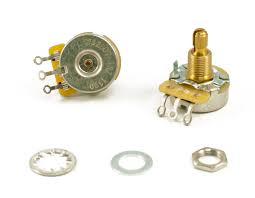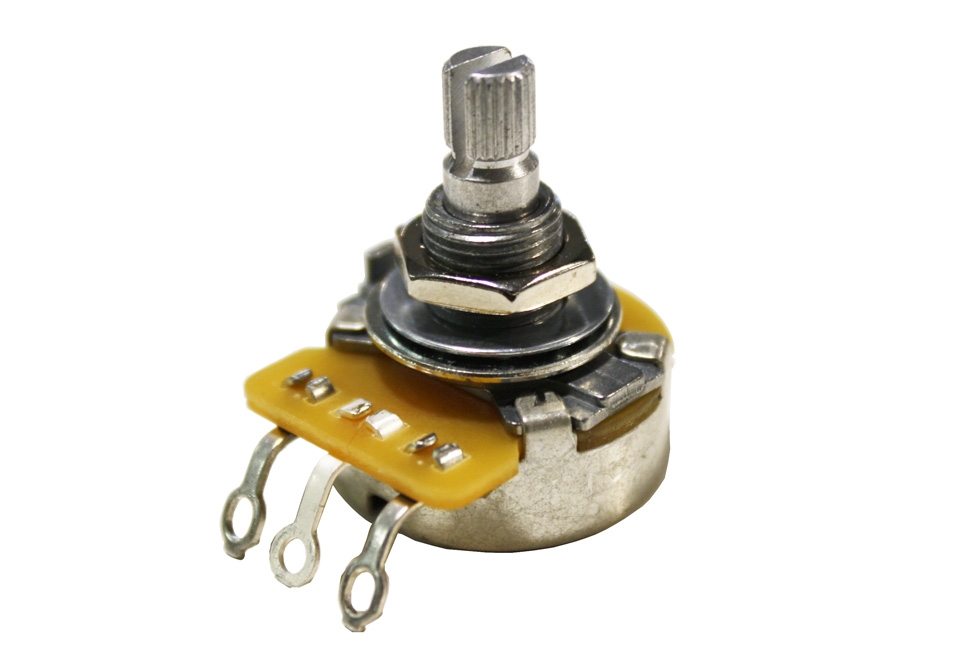
By Ed Malaker
Posted 06/15/2019
One of the most common problems that guitar players face is a worn out Volume or Tone control. You can tell when one is becoming worn out by the loud, scratching sound in your guitar signal when you turn the potentiometer up or down. This scratching sound is caused by the dust and dirt that accumulates in the casing of the potentiometer, and just from regular wear and tear. If it gets too worn out, the static sound will remain, even when the control is not being operated. This would be a good time to replace it.
Purchasing a replacement potentiometer can be a source of confusion, because it’s not always clear what value pot you should use. Many times the value is stamped right on the bottom of the potentiometer, but this is not a rule. So, with that in mind, let’s back up a bit and start with some basics.
What is a Potentiometer?
A potentiometer is a variable resistor that allows you to manually adjust the amount of resistance between zero and the value of a particular potentiometer. A pot that’s turned all the way down will add zero resistance to an electric circuit, while one that’s turned all the way up will add a resistance equal to the value of that particular potentiometer. In this article, we’re looking at pots with a value of 250,000 or 500,000 Ohms.
How Does It Work?
With no Volume Control, your guitar signal goes directly from your pickup to your amplifier. When a potentiometer is placed between the pickup and the amplifier, it provides another path for the signal to take, a way straight to ground, bypassing the amp.
When your potentiometer is turned all the way down, there is no resistance to prevent all the guitar signal from going to ground, instead of to your amplifier. This, essentially, turns your guitar off. When you turn the Volume Control on your guitar all the way up, you are placing a 250K or a 500k wall between your signal and the ground, forcing most of it to go to your amplifier. This, essentially, turns your volume up.
Why Do We Use Different Values?
We use different values because high-end frequencies can get past our resistance wall, and we must decide how much of those high frequencies we want to keep. The higher the value of your potentiometer, the greater the amount of high-end frequencies will be kept in your signal and passed to your amplifier. The lower the value of the potentiometer, the more high-end frequencies will be allowed to escape to ground.
Why Don’t We Want to Keep All Frequencies?
Single coil pickups can sometimes sound very bright and piercing, so these pickups are often paired with 250k pots (Fig 1) to allow more high frequencies to escape.
Fig 1
The two coils in a humbucker pickup cancel out many high frequencies because of phase cancellation caused by the closeness of the two coils. This makes a humbucker sound very warm, compared to a single-coil. These are often paired with a 500k pot (Fig 2) that will preserve more of the high end that remains.
Fig 2
You can customize your own tone and make it brighter or warmer by trying different pot values. There are many values available besides the standards and changing the value of either the Volume or the Tone will alter the overall sound of your guitar.
Experimentation will lead to the best results
What is the Taper?
The last thing that you need to know about pots is the taper. Each value of pot comes in two different types of taper: a Linear Taper or an Audio Taper. The taper is the way in which the value goes from zero to max.
- A linear taper goes from zero to max in a linear way, or a straight line. Halfway through, a 500k pot should have a resistance of around 250k.
- An audio taper travels from zero to max in a logarithmic way, similar to the way the human ear works. This type of pot will cause the volume to seem to change the most right when it is almost all the way up.
Guitars primarily use the linear taper pot, but some guitar players like to use the audio taper for their Tone Control pots.
We hope this has been helpful in any 250k vs 500k pots dilemmas you might have been having. For more articles on guitar electronics, visit humbuckersoup.com.


